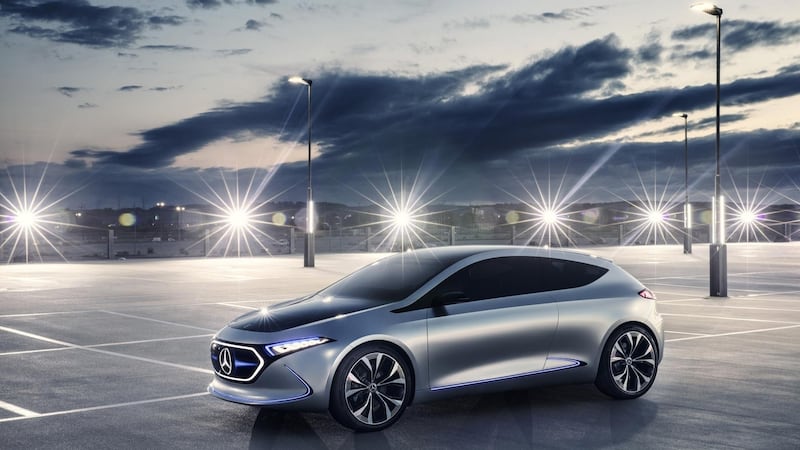Alongside its headline-grabbing Project One hypercar, Mercedes has shown off the EQA, a compact all-electric hatchback which is an obvious preview of the next-generation A-Class, as well as an expansion of the battery-powered EQ model range.
The EQA, in concept form at any rate, is actually pretty sporty, using two electric motors, one for the front wheels and one for the rears, to produce a healthy 270hp. Interestingly, the system that switches between normal and sport driving modes also changes which motor delivers more power to which wheels, raising the possibility of the first electric car ‘Drift Mode’. That driving mode change also plays with the electronic black panel between the lights. It can display a “flaming wing in horizontal format” in Sport mode, while Sport Plus switches it to an AMG GT-style ‘Panamericana’ slatted grille. The lights are also clever, a mixture of laser and fibre optics which give a particular lighting signature, designed to mimic the copper windings of an electric motor.
Mercedes claims that the car’s ultra-efficient batteries can give the EQA a one-charge range of up to 400km, and it has been designed around inductive charging to make it more convenient.
The shape of the car is also a clear nod towards the next-generation of A-Class, a model for which the EQA will, essentially, act as the range-topper. Both will be based on the same front-wheel drive platform, which will also form the basis for a new B-Class, CLA-Class, and a new A-Class four-door saloon.

"With our Concept EQA we have reinterpreted our design philosophy of Sensual Purity and developed the Modern Luxury into a Progressive Luxury for our EQ brand. We eliminated creases and lines and reached the next level of purity", said Gorden Wagener, Mercedes' head of design. "With its stunning proportions, seamless flowing surfaces, combined with stimulating graphics using high tech black panels, it is definitively a bold design statement: this car is simply sexy."
Across the show stand, Merc's GLC SUV is also breaking some new ground, as it has become what Mercedes claims is the first hydrogen fuelled plugin hybrid. Mercedes is still keen on pushing forwards with hydrogen fuel cell cars, in spite of concerns over a lack of hydrogen refuelling infrastructure, and the cost of investment needed to create one. Mercedes has put its own money into a hydrogen network, and expects 100 hydrogen filling stations to be online in Germany by the end of next year, and aiming for 400 stations by 2023.
The GLC F-Cell has a claimed 474km driving range with a topped-off battery and 4.4kg of hydrogen in its tank. The battery, a 13.8kWh unit, can power the car on its own for a maximum of 49km, and then the hydrogen fuel cell kicks in to provide power. The combined system output is 200hp, competitive with the current GLC 250d diesel. The battery takes around 90mins to fully charge while the hydrogen tank can be refuelled in around three minutes. As with a petrol-electric plugin hybrid, the GLC F-Cell can either juggle power from both battery and hydrogen sources at once, run on just the battery, or use the hydrogen system to charge the battery on the go.
The car is destined for production, but only in very limited numbers at first, and Mercedes isn’t putting a timeframe on when that will happen. It is looking at only selling the F-Cell through a lease-rental model for now, rather than outright ownership, something that most hydrogen fuel cell car makers have done so far, as the technology slowly matures.
Dusted Duster
At a far more affordable level, Dacia has unveiled its updated Duster in Frankfurt. While it keeps the same basic structure as the current car (doubtless keeping costs well and truly clamped down upon) the updated Duster does get new styling (courtesy of Renault design genius Laurens van den Acker), and an updated interior, which is of higher quality than the old one, and at last puts the central infotainment screen up high where you can see it. "By building on the strengths of its predecessor, the All-new Duster simply brings customers more – all for a price that is still unbelievably affordable," says Jean-Christophe Kugler, Dacia's vice president for Europe. "As you can see, every single feature we added helps to facilitate everyday motoring. The All-new Duster is more Duster than ever. It's an off-roader that will take customers further in even greater style and comfort."
It’s going to be a lot more sophisticated than the old Duster, with available options including a surround-view parking camera, blind spot warning, hands-free ignition, and automatic headlights. Be still, our beating (bargain-hunting) hearts…











